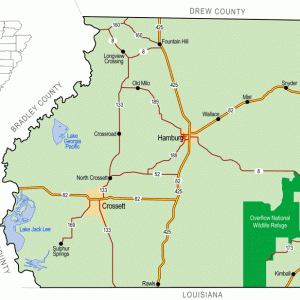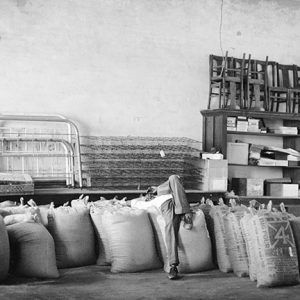calsfoundation@cals.org
Parkdale (Ashley County)
| Latitude and Longitude: | 33º07’17″N 091º32’44″W |
| Elevation: | 118 feet |
| Area: | 1.02 square miles (2020 Census) |
| Population: | 172 (2020 Census) |
| Incorporation Date: | January 4, 1902 |
Historical Population as per the U.S. Census:
|
1810 |
1820 |
1830 |
1840 |
1850 |
1860 |
1870 |
1880 |
1890 |
1900 |
|
– |
– |
– |
– |
– |
– |
– |
– |
– |
– |
|
1910 |
1920 |
1930 |
1940 |
1950 |
1960 |
1970 |
1980 |
1990 |
2000 |
|
383 |
284 |
371 |
278 |
385 |
448 |
459 |
471 |
393 |
377 |
|
2010 |
2020 |
|
|
|
|
|
|
|
|
|
277 |
172 |
|
|
|
|
|
|
|
|
One of the oldest incorporated communities in Ashley County, Parkdale (formerly known as Poplar Bluff) has benefited from its location on Bayou Bartholomew and on the Missouri Pacific railroad (now the Union Pacific railroad). Once a busy, prosperous, and even violent city, Parkdale has become a relatively quiet community in the twenty-first century.
John Tillman Hughes built a store at the present location of Parkdale in 1857. Some farmers were already working the land near the bayou at that time, including William Morris, John Harris, and William Butler. Morris’s son, John William Morris, worked as a clerk in Hughes’s store and later opened his own store. A Methodist church had also been built in the area sometime in the 1850s. The settlement that grew up around the steamboat landing was called Poplar Bluff because of a prominent grove of trees near the landing. A Missionary Baptist church was established there in 1857. A Masonic lodge opened there the same year.
Many area residents, including Butler and Morris, served in the Confederate army during the Civil War. Ashley County, aside from providing soldiers, saw moderate activity, with one skirmish in the county in March 1864. On January 31, 1865, Federal troops raided Poplar Bluff, burning a distillery, a grist mill, and a large amount of cotton and corn. Following the war, the settlement was rebuilt, with stores, saloons, mills, a post office, and the Baptist church. A public school was established in 1884. Poplar Bluff incorporated as a town in 1889.
The railroad through Poplar Bluff was completed in the early 1890s. Because the railroad also served the larger city of Poplar Bluff, Missouri, railroad officials named the depot Parkdale. The name of the post office and of the city followed suit. Sawmills were built to process cut timber, and the city grew rapidly. In 1902, Parkdale was reincorporated as a second-class city. The Bank of Parkdale was established by 1905. Stores near the depot included a druggist, a pharmacy, several mercantile establishments, and an auction house. M. R. White published a newspaper, the Parkdale News. A bridge was built across the bayou in 1908, costing $8,000 in Ashley County funds and an additional $1,500 in local funds. A new frame schoolhouse was built in 1908; it was then replaced by a brick school building in 1917. A separate school for African Americans met outside the city limits. A telephone exchange was operating by 1912. The Baptist congregation, which had declined in size, was revitalized by a revival service in 1909 and constructed a new church building the following year.
In the early part of the twentieth century, Parkdale became notorious for violent crimes, including murders. Historian Y. W. Ethridge described Parkdale as a “boisterous community” due to the railroad, sawmills, and saloons. One citizen later said, “Parkdale was terrible. There were a bunch of outlaws. It was a shoot-up town….There was a rough and rowdy white element here. It was wild.” One of the most unusual crimes in Parkdale was the lynching of Ernest Williams, an African-American man, in June 1908. A group of African-American women had organized a league to enforce better moral conduct, and Williams had evidently not complied with their standards. Consequently, they seized him one evening, dragged him to a telegraph pole on the outskirts of Parkdale, and hanged him. His body was not discovered by local authorities until the next morning, and no one was ever charged with the crime.
A new Methodist church was constructed in the city in 1926. Because of its location on high ground, Parkdale was not affected by the Flood of 1927. Arkansas Power and Light (AP&L) established electrical service in 1927, and a water system was installed in the city in 1930. As late as 1939, Parkdale’s cotton gins led the county in cotton production, with 2,600 bales of cotton ginned. A fire in 1940 destroyed part of the city, but buildings were rebuilt, and the city continued to flourish beyond the middle of the twentieth century.
After 1970, however, stores began to close, and buildings were abandoned. A tornado in 1990 brought further damage to the city. The Parkdale post office was renamed in 2006 for civil rights activist Willie Vaughn, a resident of Parkdale for most of his life. Parkdale was also the childhood home of Danny Davis, a prominent Chicago, Illinois, politician who began serving in the U.S. House of Representatives in 1997. Parkdale is part of the Hamburg School District. Parkdale remains home to the Bayou Grain and Chemical Corporation, Parkdale Baptist Church, and Penny Chapel Christian Methodist Episcopal Church.
Four properties in Parkdale are listed on the National Register of Historic Places: the Baptist church built in 1910, the Methodist church built in 1926, the house of Dr. M. C. Hawkins built in 1912, and the house of Dr. Robert George Williams built in 1903.
Lawyer and judge Turner Butler was born in Parkdale when it was called Poplar Bluff. John Caldwell was a well-known banker and community leader in Parkdale whose art career took off late in life, and he became widely known for his award-winning wood engravings and woodblock prints.
For additional information:
DeArmond-Huskey, Rebecca. Bartholomew’s Song: A Bayou History. Bowie, MD: Heritage Books Inc., 2001.
Etheridge, Y. W. History of Ashley County, Arkansas. Van Buren, AR: The Press-Argus, 1959.
Hillen, Michelle. “Parkdale Post Office to Bear Name of Civil-Rights Advocate.” Arkansas Democrat-Gazette, August 3, 2006, p. 1B.
Steven Teske
Butler Center for Arkansas Studies
 Ashley County Map
Ashley County Map  Parkdale General Store
Parkdale General Store 



I’ve been looking for family of Henry and Georgia Simpson Neal. My father George Pugh Neal was born in Parkdale, Arkansas, 1911. Trying to find my father’s mother Georgia Simpson Neal’s legacy.
I have an old Empire Saloon six-sided coin with PARKDALE, ARK stamped on it with the number “15” on the back. I’m wondering about the history surrounding this.
My dad Frank Dale Jr. was born in Parkdale, Arkansas, as were his sister and aunts and uncles. Also the Cobbs family. They were African Americans. I remember in 1963 when I visited it was a cotton field farther than the eye could see. There were railroad tracks, an outhouse, and a red clay road. On the other side of the road were old gray homes looking like shacks, with rags and newspaper in the cracks. I remember a storefront called Gustavia’s. My cousin Francis Cobbs had a house with a toilet inside. My cousin Woodie Sellars had a new house his dad built. That’s where I slept. They had all the amenities. Down the road across from the tracks and field was a Baptist church. The opposite direction (far away to me as a six year old) was the town, where the post office, store, and washateria (laundromat) were. I also remember the influx of mosquitos. My dad passed in 2013. My mom Dorothy Lee Lockett is eighty-eight. She married my dad at the age of sixteen. So, she remembers the way it was, and the names and history of Parkdale.